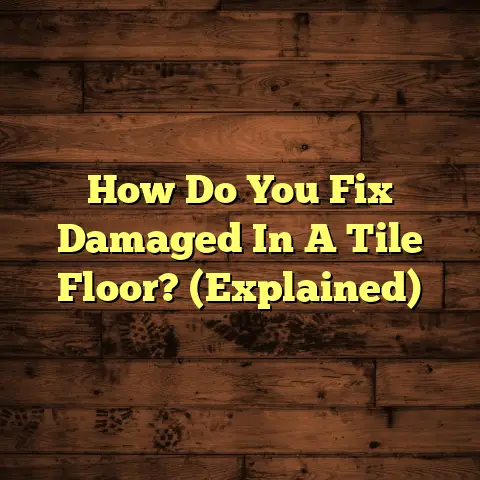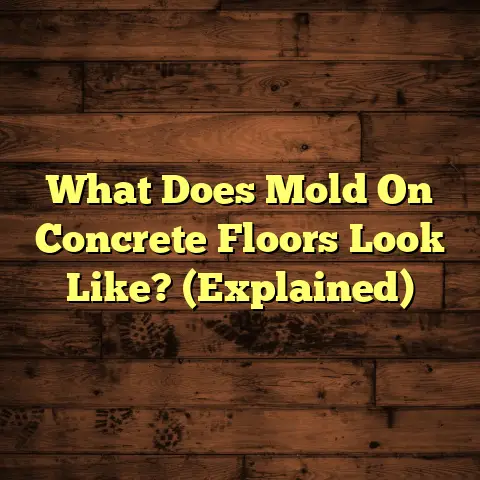Wood Floor Expansion: What Is It? (3 Warning Signs!)
Much like a tree bending and swaying in the wind, wood floors aren’t static. They move, they breathe, and they react to their environment.
I’ve seen it all in my years as a flooring contractor – from perfectly installed floors that last decades, to beautiful floors ruined in just a few seasons.
And one of the biggest culprits? Wood floor expansion.
Let’s dive deep into understanding what it is, why it happens, and most importantly, what warning signs to look out for.
Understanding Wood Floor Expansion
What exactly is wood floor expansion?
Simply put, it’s the natural increase in size that wood experiences when it absorbs moisture from the air. Wood is a hygroscopic material.
Think of it like a sponge. When it’s dry, it’s smaller and rigid. When you soak it in water, it expands and softens.
Wood does the same thing, just less dramatically.
The Science Behind Wood and Moisture
The real magic (or frustration, depending on how you look at it) lies in wood’s cellular structure. Wood cells have tiny spaces that can fill with water.
As humidity rises, the wood absorbs moisture from the air, causing these cells to swell. This swelling results in an overall increase in the wood’s dimensions, primarily across the grain.
Temperature also plays a role. While moisture is the primary driver of expansion, higher temperatures can accelerate the process.
According to the Forest Products Laboratory, for every 1% change in moisture content, wood can expand or contract by about 0.1% to 0.3% across its width. (Source: USDA Forest Service)
It might not sound like much, but when you’re talking about an entire floor, those small changes can add up!
Different Wood, Different Reactions
Not all wood is created equal. Some species are more stable than others, meaning they’re less prone to expansion and contraction.
Here’s a quick rundown:
-
Oak: A popular choice, known for its durability and moderate stability. It expands and contracts, but usually within a manageable range.
-
Maple: Harder than oak, but also more prone to expansion, especially in areas with high humidity.
-
Hickory: Very hard and durable, but can be unstable if not properly acclimated.
-
Engineered Wood: Constructed with multiple layers of wood veneer, this type of flooring is more stable than solid wood.
-
Exotic Hardwoods (Brazilian Cherry, Ipe): Often very dense and can be more stable than domestic species, but acclimation is crucial.
As a general rule, denser woods tend to be more stable, but proper acclimation is key for any species.
The Causes of Wood Floor Expansion
Now that we know what wood floor expansion is, let’s talk about what causes it.
Environmental Factors
The biggest culprits are:
-
Humidity Levels: This is the number one factor. High humidity means more moisture in the air, which means more moisture absorbed by the wood. I’ve seen floors buckle after just a few days of extremely humid weather.
-
Seasonal Temperature Changes: As temperatures rise, the air can hold more moisture, leading to higher humidity levels. Winter can also be a problem. When we crank up the heat, the air becomes dry, causing the wood to contract. Then when the weather changes back, we’re back to square one.
-
Water Spills and Leaks: Obvious, right? But you’d be surprised how often this happens. A leaky pipe, a spilled glass of water, even a houseplant that’s overwatered can all contribute to expansion.
The Importance of Acclimation and Installation
Proper installation is just as important as choosing the right wood. And a key part of proper installation is acclimation.
Acclimation means allowing the wood to adjust to the home’s environment before it’s installed.
Here’s how it works:
-
Deliver the wood to the job site: At least 3-5 days before installation (or longer, depending on the species and climate).
-
Spread out the boards: Don’t leave them stacked in a pile. This allows air to circulate around each board.
-
Maintain consistent temperature and humidity: Keep the HVAC system running at a normal living temperature.
-
Check the moisture content: Use a moisture meter to ensure the wood’s moisture content is within the recommended range for your area.
If you skip this step, you’re asking for trouble. I’ve seen floors installed without acclimation that buckled within weeks.
Subflooring and underlayment also play a role. A solid, level subfloor is essential for a stable floor. Underlayment can provide a moisture barrier and cushioning.
The Warning Signs of Wood Floor Expansion
Okay, so how do you know if your wood floor is expanding? Here are three warning signs to watch out for:
Warning Sign #1: Gaps Between Floorboards
Gaps are one of the most common signs of expansion and contraction. In the winter, when the air is dry, the wood shrinks, creating gaps between the boards.
These gaps are usually small, but they can be unsightly. And they can also trap dirt and debris, making cleaning more difficult.
Here’s what to look for:
-
Small gaps: Hairline cracks between boards, usually more noticeable in the winter.
-
Wider gaps: Larger gaps that appear during periods of extreme dryness.
-
Uneven gaps: Gaps that are wider in some areas than others, indicating uneven moisture levels.
Warning Sign #2: Buckling or Cupping
Buckling and cupping are more severe signs of expansion. Buckling occurs when the floorboards lift up from the subfloor, creating a wave-like effect.
Cupping is when the edges of the boards rise up higher than the center, creating a concave shape.
Both buckling and cupping are caused by excessive moisture. The wood expands so much that it has nowhere to go, so it starts to deform.
Here’s what to look for:
-
Raised areas: Sections of the floor that are higher than the surrounding areas.
-
Wavy appearance: A noticeable wave or ripple effect across the floor.
-
Concave boards: Boards that are sunken in the middle and raised at the edges.
Warning Sign #3: Cracking or Splitting
Cracking and splitting are the most serious signs of expansion. They indicate that the wood has been subjected to extreme stress.
Excessive expansion can cause the wood fibers to separate, resulting in cracks or splits. These cracks can be small and superficial, or they can be large and deep, compromising the structural integrity of the floor.
Here’s what to look for:
-
Hairline cracks: Small, thin cracks that run along the grain of the wood.
-
Larger cracks: Wider cracks that are easily visible.
-
Splits: Deep cracks that separate the wood fibers.
The Consequences of Ignoring Wood Floor Expansion
Ignoring these warning signs can have serious consequences.
Damage to the Flooring
Left unchecked, expansion can cause permanent damage to your wood floor.
Gaps can widen, buckling and cupping can worsen, and cracks can deepen. Eventually, the floor may need to be replaced.
Reduced Home Value
A damaged wood floor can also reduce the value of your home. Potential buyers may be turned off by visible signs of expansion.
According to real estate agents, damaged flooring is one of the top things that can lower a home’s selling price.
Costly Repairs and Replacements
Small gaps can be filled with wood filler, but buckling and cupping may require sanding and refinishing. In severe cases, the entire floor may need to be replaced.
Conclusion
Wood floor expansion is a natural phenomenon, but it doesn’t have to be a problem.
By understanding the causes of expansion, recognizing the warning signs, and taking proactive steps to manage moisture levels, you can protect your wood floor and keep it looking beautiful for years to come.
Don’t ignore those warning signs! If you see gaps, buckling, cupping, or cracking, call a professional flooring contractor right away.
It’s always better to address these issues early before they become major problems.
Your floor will thank you for it!





